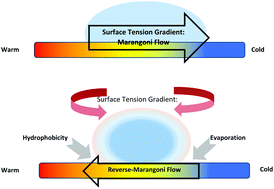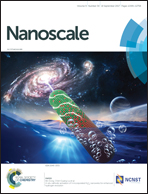Mimicking wettability alterations using temperature gradients for water nanodroplets†
Abstract
A sessile droplet or a film usually moves from hotter regions to colder regions, due to variations in interfacial tension. This, known as the so-called Marangoni effect, is true for most pure liquids like water for which the surface tension decreases with an increase in temperature. In stark contrast to this existing understanding, we bring forth the coupled effect of wettability and temperature gradients on the dynamics of the three-phase contact line. By simultaneously tracking the dynamic evolution of the three-phase contact line due to the evaporation and diffusion of molecules through molecular dynamics simulations, we explore the coterminous effects of the change of surface tension coefficients and wetting parameters with temperature on sessile droplets residing on surfaces with different wettabilities. We demonstrate, for the very first time, that the inverse Marangoni effect, which is believed to be exclusively observed in mixtures and self-rewetting fluids, is feasible in pure water at scales where inertial effects are negligible. The results of the study find application in electronic chip cooling where by the combined tuning of surface characteristics and Marangoni forces, droplets can be passively transported to warmer regions for efficient thermal management.



 Please wait while we load your content...
Please wait while we load your content...